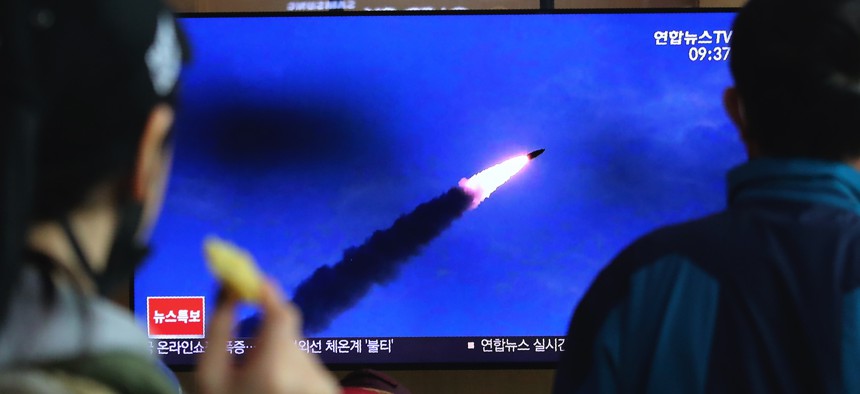
People watches a televsion screen showing a file image of North Korea's missile launch during a news program at the Seoul Railway Station in Seoul, South Korea, Saturday, March 21, 2020. AP / Ahn Young-joon
Trump’s Nuclear Policy Has Failed
Recognizing that blunders and bad ideas have undermined stability and security is the first step toward recovery.
Mixed messages from the highest levels of government. A lack of coordination among key officials. Sidelining experts with key experience. A failure to prepare and downplaying the consequences of failure. Seeking the quick fix and failing to do the hard work to achieve success for the American people.
These are critiques that have been leveled at the White House’s failed response to the current pandemic, but these are also traits on vivid display in the Administration’s failed handling of an even more dangers set of issues: America’s nuclear security. All of the nuclear challenges facing the United States – including those President Trump inherited and those of his own making – are getting worse. The risk of nuclear use, of nuclear instability and the proliferation of nuclear weapons continue to increase and the actions being pursued (or ignored) by this administration are creating more chaos than security. This is the central finding of a new report by the American Nuclear Policy Initiative: “Blundering Toward Nuclear Chaos: The Trump Administration After 3 Years,” with contributions by some of the most insightful nuclear experts in the country.
Sadly, nuclear dangers are worse no matter where you look. Even in those areas where the President and his team have laid out reasonable goals, the flawed approach to planning, poor policy implementation, a lack of prioritization, and inconsistent follow-through has led to a complete failure to achieve those stated outcomes.
Nowhere are the failures of this administration on clearer display than with the complex nuclear issues of Iran and North Korea. President Trump came into office criticizing the Iran nuclear deal, claiming he would negotiate a better one. And for almost a year, his administration told Europe that America wanted a better deal. Yet despite some initial progress, the President abandoned any multilateral diplomacy and withdrew the U.S. from the nuclear pact with Tehran. The result was predictable: Iran has eased its commitment to key nuclear constraints, and America has less influence with Europe, Russia, or China to achieve any tangible outcome.
Related: America’s Allies Are Becoming a Nuclear-Proliferation Threat
Related: How Quickly Could Iran Get a Nuclear Bomb?
Related: Nuclear Experts Beg Congress to Push Back on Trump Administration’s ‘Dangerous Impulses’
On North Korea, the dynamics are different, but the results the same. Investing in a high-stakes, high-reward gambit of summits left the U.S. worse than empty-handed. North Korea continues to expand its nuclear and missile capabilities, even while expanding its global connections and acceptability. U.S. diplomatic efforts are at a complete standstill, and hard-won sanctions pressure on North Korea erodes day by day. Our alliance with South Korea is less stable, and our influence over the DPRK and China are lower than ever.
In both these cases, deliberate choices and overconfidence by the Trump administration increased the nuclear danger to America and its allies, and left the U.S. in a weaker position to reverse the damage done by undermining our alliances and proven security tools.
The record is equally devoid of progress in managing the nuclear risks with Russia. The administration has laid out what seems like a reasonable goal of bringing China into the arms control, transparency, and reduction process. But in a move no experienced practitioner believes will work, Trump refuses to extend the last remaining nuclear reduction pact with Russia – the New START Treaty – unless China climbs on board. Russia and the U.S. are fully complying with the agreement which caps strategic numbers of both countries under effective verification. Yet instead of accepting Russia’s unconditional extension of the pact for five years, a step that would decidedly benefit American security and stability, Trump has linked the extension to his China gambit. At the same time, Trump has seemingly welcomed a new arms race with Russia, and is seeking to accelerate the already expensive modernization of U.S. nuclear forces and has deployed a new, lower yield, more usable nuclear weapon that lowers the threshold to nuclear use. With no negotiating team or strategy, the prospects for nuclear stability are fading by the day.
In these and other areas, the trends are overwhelmingly negative. Sadly, these trends cannot be quickly reversed. Policy choices and behavior of the administration has undermined America’s longstanding credibility and partnerships. And worse, the capabilities needed to achieve nuclear success, from an effective intelligence community to a confident civil and foreign service who do the hard work of nuclear security have all been undermined and neglected. The muscle memory of nuclear security is eroding, and will take years to repair.
Every president has the right to set nuclear policy. But by adopting a disruption strategy, and by hollowing out the skills and tools needed to achieve success, this administration has made America less safe. By any measure, all of the nuclear challenges facing the United States have gotten worse over the last three years and only a change of policy and process can reverse these trends. None of the problems we face have easy solutions, but recognizing that current policy has failed is the first needed step to adopting more realistic, achievable goals and putting in place the means and approaches to achieve them.
NEXT STORY: Can China Use the Pandemic to Displace the US?



